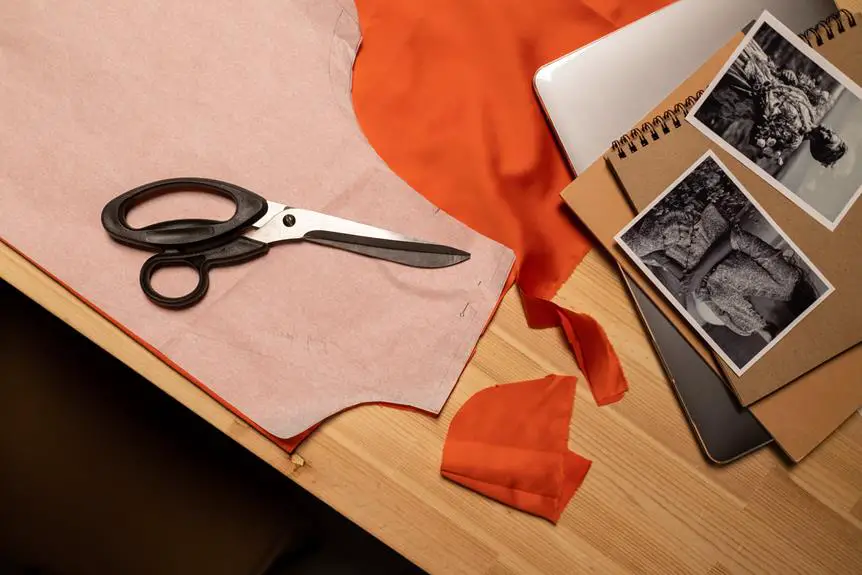So, you've mastered the art of crafting exquisite buttonholes in fabrics, but are your scissors up to the task? Discovering the best scissors for cutting buttonholes in fabrics requires precision and insight.
Consider the intricacies of various fabric weights, ergonomics, and maintenance to ensure the perfect cut every time. In this pursuit of mastery, selecting the ideal tool is paramount.
Let's delve into the world of buttonhole scissors and explore the features that set the best ones apart.
Key Takeaways
- Scissors made from durable materials like stainless steel or high-carbon steel are ideal for cutting buttonholes in fabrics.
- Specialized buttonhole scissors with sharp, narrow blades and a spring mechanism can reduce hand fatigue.
- Small sharp embroidery scissors or snips can be used as alternatives for cutting buttonholes.
- It is important to keep scissors sharp and in good condition for clean and accurate cuts.
Types of Scissors for Cutting Buttonholes
When cutting buttonholes in fabrics, it's essential to use scissors made from durable materials such as stainless steel or high-carbon steel. These materials ensure that the scissors remain sharp for a long time and can withstand the pressure of cutting through various fabric weights.
Specialized buttonhole scissors are specifically designed for creating buttonholes. These scissors have a sharp, narrow blade that allows for precise cutting and clean edges, essential for creating professional-looking buttonholes. They often have a spring mechanism that helps to reduce hand fatigue during extended use.
While specialized buttonhole scissors are ideal for this task, alternatives such as small sharp embroidery scissors or snips can also be used effectively, especially for smaller buttonholes.
However, it's important to ensure that whichever scissors are chosen, they're kept sharp and in good condition to achieve the best results when cutting buttonholes in fabrics.
Features to Look for in Buttonhole Scissors
When selecting buttonhole scissors, it's essential to look for sharp, precise blade edges that can cleanly cut through fabric.
Additionally, a comfortable grip is crucial for maintaining control and accuracy while cutting.
These features ensure that you can create neat and professional-looking buttonholes in various types of fabrics.
Sharp, Precise Blade Edges
Selecting buttonhole scissors with sharp, precise blade edges is essential for achieving clean and accurate cuts in fabric. Blade maintenance is crucial to ensure the sharpness of the edges. Look for scissors with high-quality stainless steel blades that can be easily sharpened when needed.
Additionally, consider the cutting techniques you'll be using. For example, if you prefer to cut buttonholes in a single snip, choose scissors with a longer blade for increased precision. Alternatively, if you prefer to cut buttonholes with multiple small snips, a pair with a shorter blade may provide better control.
Understanding the different cutting techniques and how they align with the blade length will help you make an informed decision when selecting buttonhole scissors with sharp, precise blade edges.
Comfortable Grip for Control
To achieve precise and controlled cuts, look for buttonhole scissors with a comfortable grip that allows you to maintain a steady hold while cutting through fabric. An ergonomic design is essential to minimize hand fatigue and provide optimal control.
Look for scissors with handles that fit comfortably in your hand, allowing for a natural and relaxed grip. Ergonomically designed buttonhole scissors help distribute the pressure evenly, reducing strain on your hand and fingers during extended use. This feature is crucial for achieving clean and accurate buttonholes without compromising on comfort.
When selecting buttonhole scissors, prioritize ergonomic design to ensure that you can maintain a steady and controlled grip, ultimately enhancing your cutting precision while minimizing hand fatigue.
Best Scissors for Lightweight Fabrics
When it comes to cutting lightweight fabrics, sharp micro-tip blades are essential for achieving precise and intricate cuts.
Look for scissors that are comfortable and lightweight, as they'll enable you to work with ease and accuracy.
The right pair of scissors can make all the difference when working with delicate fabrics.
Sharp Micro-Tip Blades
You need sharp micro-tip blades for cutting lightweight fabrics. When working with delicate materials, precision and control are crucial. Here are key considerations for selecting the best scissors:
- Micro-Tip Precision: Look for scissors with ultra-fine, pointed tips. These micro tips allow for intricate cutting without causing fraying or damage to the fabric edges.
- Blade Material: Opt for high-quality stainless steel blades. These blades aren't only durable but also maintain sharpness, ensuring clean and precise cuts through lightweight fabrics.
- Comfortable Grip: Choose scissors with ergonomic handles for extended cutting sessions. A comfortable grip reduces hand fatigue and provides better maneuverability, enhancing your ability to execute intricate fabric cutting techniques with ease.
Selecting scissors with sharp micro-tip blades is essential for achieving precise and clean cuts in lightweight fabrics, ultimately elevating the quality of your sewing projects.
Comfortable and Lightweight
For comfortable and lightweight scissors suitable for cutting lightweight fabrics, it's important to prioritize a design that offers ergonomic handles and a manageable weight, ensuring prolonged use without causing strain or discomfort.
Look for scissors with an ergonomic design that fits comfortably in your hand, allowing for a natural grip and reducing hand fatigue during extended use.
Additionally, consider scissors made from lightweight materials, such as high-quality stainless steel or titanium, to minimize strain on your hand and wrist. The balance of the scissors is also crucial, as a well-balanced pair can reduce tension in your hand and forearm.
Prioritizing comfort and lightweight features in your scissors will enhance precision and control when cutting lightweight fabrics, making your sewing projects more enjoyable and efficient.
Precision for Intricate Cuts
To achieve precise and intricate cuts on lightweight fabrics, prioritize scissors with ultra-sharp blades and fine points, ensuring effortless maneuverability and clean, accurate buttonhole cuts. With comfortable and lightweight scissors, you can enhance your sewing experience by seamlessly transitioning from lightweight to more intricate fabrics, maintaining control and precision throughout.
- Ultra-sharp blades: Look for scissors with exceptionally sharp blades to effortlessly glide through lightweight fabrics, allowing for precise and clean cuts.
- Fine points: Scissors with fine points enable you to navigate intricate patterns and curves with ease, ensuring accurate buttonhole cuts without any fabric slippage.
- Ergonomic design: Seek scissors with an ergonomic design that fits comfortably in your hand, minimizing hand fatigue and enhancing precision cutting during prolonged use.
Best Scissors for Medium-weight Fabrics
The best scissors for medium-weight fabrics are those with a sharp, fine edge to ensure precise cutting. When working with medium-weight fabrics such as wool crepe or twill, it's essential to have scissors that can effortlessly glide through the material without causing fraying or uneven edges. Additionally, ergonomic design plays a crucial role in reducing hand fatigue during extended cutting sessions. Look for scissors with comfortable handles and a balanced weight distribution to minimize strain on your hands and wrists.
Here's a comparison of some popular scissors for medium-weight fabrics:
| Scissors Model | Blade Material | Handle Design |
|---|---|---|
| Brand A | Stainless steel | Ergonomic, rubberized grip |
| Brand B | High carbon steel | Offset handles for ergonomic cutting |
| Brand C | Titanium coated | Soft-grip handles |
Each of these scissors offers a sharp, precise cutting edge suitable for medium-weight fabrics, but the ergonomic handle designs vary. When choosing the best scissors for medium-weight fabrics, consider both the blade material and the handle design to find the perfect balance of sharpness and comfort for your cutting techniques.
Best Scissors for Heavyweight Fabrics
When cutting heavyweight fabrics, it's important to select scissors with strong, durable blades and comfortable handles that can withstand the thickness and density of the material. Heavy duty durability is essential for heavy fabrics like denim, canvas, or upholstery material. Here are key features to consider when choosing the best scissors for heavyweight fabrics:
- Heavy Duty Durability: Look for scissors specifically designed for heavy-duty cutting. These scissors are engineered with robust, sharp blades that can effortlessly slice through dense materials without becoming blunt or damaged. Additionally, heavy-duty scissors often have a reinforced construction to ensure longevity and resilience when dealing with tough fabrics.
- Comfortable Handles: Consider scissors with ergonomic handles that provide a comfortable grip. When working with heavyweight fabrics, ergonomic handles reduce hand fatigue and allow for extended use without discomfort. Look for cushioned or rubberized handles that offer a secure grip and control, enabling precise cutting even through thick materials.
- Cutting Thick Materials: Seek out scissors that are explicitly labeled for cutting thick materials. These scissors are designed to tackle the challenges of heavyweight fabrics, offering the necessary strength and sharpness to effortlessly cut through layers of dense material without causing fraying or uneven edges.
Selecting scissors with heavy duty durability and the ability to cut thick materials is crucial for achieving precise and clean cuts in heavyweight fabrics.
Ergonomic Considerations for Buttonhole Scissors
Consider the handle grip when selecting buttonhole scissors, ensuring it provides comfort and control during precise cutting. Ergonomic design plays a crucial role in preventing hand fatigue and ensuring smooth, accurate cutting of buttonholes in fabrics.
Look for scissors with an ergonomic handle that fits comfortably in your hand, allowing for prolonged use without strain. The handle should provide a secure grip, reducing the risk of slippage and enhancing control over the cutting motion. Additionally, consider the weight of the scissors as excessive weight can lead to hand fatigue over extended use. Opt for lightweight yet durable materials that offer a balance between sturdiness and ease of handling.
Some buttonhole scissors feature cushioned or padded handles, further enhancing comfort during use. Prioritize scissors with an ergonomic design that aligns with the natural movement of your hand, minimizing strain on the muscles and joints.
Maintaining and Sharpening Buttonhole Scissors
To maintain optimal performance, regularly sharpen and lubricate your buttonhole scissors to ensure smooth, precise cutting and prolonged usability. Here are some essential tips for maintaining and sharpening your buttonhole scissors:
- Cleaning and Lubrication: After each use, clean the blades of your buttonhole scissors with a soft, dry cloth to remove any fabric residue or debris. Apply a small amount of scissor lubricant to the pivot point and the blades to keep them moving freely. This prevents rust and ensures the smooth opening and closing of the scissors.
- Sharpening Techniques: Use a sharpening stone or a scissor-specific sharpener to maintain a sharp edge on the blades. Hold the scissors at the correct angle and stroke the blades across the sharpener to remove any dullness. Ensure that both blades receive an equal number of strokes to maintain balance.
- Storage: When not in use, store your buttonhole scissors in a protective case or sleeve to prevent damage to the blades. This also helps maintain the alignment of the blades, ensuring consistent cutting performance.
Frequently Asked Questions
Can Regular Scissors Be Used for Cutting Buttonholes in Fabrics?
Yes, regular scissors can be used for cutting buttonholes in fabrics, but it's recommended to use fabric scissors or tailor's shears for a cleaner cut. However, if using regular scissors, ensure they are sharp and precise.
Are There Any Specific Techniques for Cutting Buttonholes With Scissors?
When cutting buttonholes with scissors, specific techniques are crucial for precision cutting. Consider the fabric type and use buttonhole scissors for best results. Mastering these skills will ensure clean, professional-looking buttonholes in your fabric projects.
Can Left-Handed Individuals Use the Same Buttonhole Scissors as Right-Handed Individuals?
Yes, left-handed individuals can use buttonhole scissors designed for their dominant hand. When cutting buttonholes, ensure the fabric is stabilized and use a sharp, precision pair of left-handed scissors for clean, accurate cuts.
Are There Any Safety Precautions to Keep in Mind When Using Buttonhole Scissors?
When using buttonhole scissors, safety precautions are crucial. Proper handling involves keeping fingers clear of the blades and using a cutting mat. Maintain the scissors by keeping them clean and dry, and store them in a secure place to prevent accidents.
Can Buttonhole Scissors Be Used for Cutting Other Materials Besides Fabric?
Buttonhole scissors, whether metal or plastic, are best suited for cutting fabrics and may not perform as well on other materials. They offer precision for buttonholes, but for other materials, rotary cutters may be more effective.
- How Does Ring Spun Cotton Affect Garment Fit and Shape Retention? - August 13, 2024
- What Are the Challenges in Producing Ring Spun Cotton? - August 13, 2024
- Is Ring Spun Cotton Suitable for Plus-Size Clothing? - August 13, 2024






